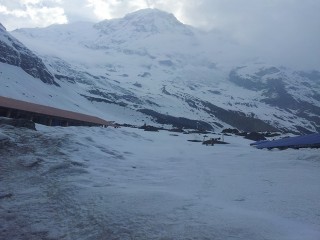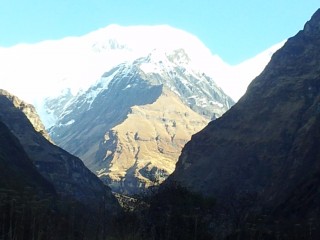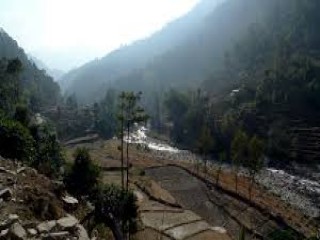Introduction
One of the newly opened regions, the trek to the Nar and Phu valley takes you to a remote but alluring region of Nepal. Unlike other regions of Nepal, trekking the region of Nar and Phu you will observe that the landscape is similar to that of Tibet.
You will enjoy the delightful sights of quaint Tibetan villages, astounding rock formations, high altitude grazing settlements, narrow canyons, deep forests and majestic snow clad peaks during your trek to the Nar and Phu valley.
The trail follows a rugged path as you explore the quaint Tibetan villages of Nar and Phu, cross the Kang La Pass, take the less traveled route to Tilicho Lake and the Meso Kanta Pass (5089m) which links the Manang and Kali Ghandaki valley. This traversing of the pass provides you a more challenging and interesting alternative to the popular Thorong La pass on the Annapurna Circuit.
Outline Itinerary
Day 1 Arrival in Kathmandu / O/n at hotel / Welcome dinner
Day 2 City sightseeing in and around Kathmandu valley.
Day 3 Drive from Kathmandu to Beshishahar (760m.) takes approximately seven hours.
Day 4 Trek from Beshishahar to Bahundanda (1310m.) takes about six hours.
Day 5 Trek from Bahundanda to Chamje (1430m.) takes approximately six hours.
Day 6 Trek from Chamje (1410m.) to Dharapani (1860m.) takes about six hours.
Day 7 Trek from Dharapani to Koto takes about five hours.
Day 8 Trek from Koto to Dharmasala takes about six hours.
Day 9 Trek from Dharmasala to Kayang takes about six and half hours.
Day 10 Trek from Kayang to Phu village.
Day 11 Excursion around Phu valley.
Day 12 Trek from Phu valley to Junam.
Day 13 Trek from Junam to Nar.
Day 14 Trek from Ngwal to Manang takes about three hours.
Day 15 Trek from Manang to Khangsar takes approximately five hours.
Day 16 Trek from Khangsar to Tilicho Lake takes about six hours.
Day 17 Trek from Tilicho Lake to Mesokanto Pass (5315m.) takes about seven hours.
Day 18 Trek from Mesokanto Pass to Jomsom (2741 m.) via Thimi (2760 m.) takes about six hours.
Day 19 Fly from Jomsom to Pokhara which takes about 25 minutes.
Day 20 Drive from Pokhara to Kathmandu by tourist mini bus that takes about seven hours.
Day 21 Transfer to the Airport for final departure. (Fly out from Kathmandu).
Day 1 : Arrival in Kathmandu / O/n at hotel / Welcome dinner
Arrive in Kathmandu International Airport. Transfer to the hotel and stay overnight at hotel in Kathmandu.
Accomodation : -
Day 2 : City sightseeing in and around Kathmandu valley.
City sightseeing in and around Kathmandu valley. (Kathmandu, Bhaktapur & Patan). Stay overnight at hotel in Kathmandu.Accomodation : -
Day 3 : Drive from Kathmandu to Beshishahar (760m.) takes approximately seven hours.
You drive along the Kathmandu-Pokhara Highway to Dumre and then follow the narrow and paved road by the Marshyangdi River to Besi Sahar (823m.). Beshishahar is the district headquarters of Lamjung district. All the local government offices are situated here. From here, you can see some of the mountain peaks, natural sceneries surrounding the valley and the daily activities of local people. This headquarters is the centre from where the daily usable commodities are supplied to the different villages and numerous towns. Stay overnight at camp in Beshisahar.Accomodation : -
Day 4 : Trek from Beshishahar to Bahundanda (1310m.) takes about six hours.
The first part of the trail passes through flat level ground along the bank of the Marshyangdi river. You can enjoy the sceneries and the local culture of Gurung community. After lunch at Ngadi, the trail goes steeply upwards to Bahundanda which takes about two hours. At this point, you can see the area surrounded by eye-catching sceneries with snow capped mountains. Stay overnight at camp in Bahundanda.Accomodation : -
Day 5 : Trek from Bahundanda to Chamje (1430m.) takes approximately six hours.
A steep trail descends for early half an hour and then follows a flat path through rice terraces, before crossing a stream at the bottom of a small waterfall. It then climbs again and traverses the hillside high above the river before reaching the village of Lali Gaon. Ahead, the Marshyangdi valley forms a steep V-shape and you follow the winding mountain path down through Syange (1100m.) where there is a beautiful waterfall above and along the river for some distance. The trail then climbs steeply and the path is cut into the sheer cliff-face some 200-300m above the riverbed. Eventually you descend to the stone village of Jagat (1330m.) situated on a shelf which juts into the precipitous Marshyangdi valley. Now, the trail begins to observe small ups and downs to Chamje through the forests. Stay overnight at camp in Chamje.Accomodation : -
Day 6 : Trek from Chamje (1410m.) to Dharapani (1860m.) takes about six hours.
The first part of the trail descends to the river and after crossing a suspension bridge, you begin a climb to Sattale (1550m.) on a path so steep that it seems one slip would send you hurtling down into the valley. Climbing the zigzagged path to the top of the hill, you see the level, plain of Tal (1700m.) ahead of you. Tal is the border between Manang and Lamjung district. Though it is enclosed by cliffs, the level area looks reassuring after the harrowing mountain paths just traveled on. You descend to a grassy riverbank, which leads to Tal with its hotels and teahouses. Beyond Tal, the valley narrows and the path becomes high and winding. Beyond the small village of Karte (1900m.), there is a bit more cliff-walking before the path reaches near the river. You cross a suspension bridge, and climb the short distance to the stone Kani marking the entrance to Dharapani (1960m.). Stay overnight at camp in Dharapani.Accomodation : -
Day 7 : Trek from Dharapani to Koto takes about five hours.
You trek a gradually ascending path and cross a stream to reach Koto. The mountain views you can enjoy are of Annapurna II and Manaslu range along with beautiful views of forests on the way which add another dimension to your trek. Koto is a small village mainly inhabited by Gurung and other ethnic groups. Their lifestyle is mainly influenced by Buddhist Tibetans. Stay overnight at camp in Koto.Accomodation : -
Day 8 : Trek from Koto to Dharmasala takes about six hours.
This morning you head out early, as you have a long and somewhat difficult day before you. You cross the river leading to the Nar Phu valley and hike up through beautiful woods above the Phu Khola. The route takes you through some beautiful woods and past several small caves, and a pilgrims’ Dharmasala. After you emerge out of a narrow canyon, the trail actually passes under a wide waterfall just before the Dharmasala, from where the woods become thinner and the vistas wider. Stay overnight at camp in Dharmasala.Accomodation : -
Day 9 : Trek from Dharmasala to Kayang takes about six and half hours.
A steep climb up the valley along a small river brings you to high pastures on a 3,200m plateau. You pass by the scenic kharka of Meta, 3560m, a non permanent winter settlement of Nar, where you are likely to share the trail with a few yaks! This morning is one of the loveliest walks in the Himalayas. The landscape is combined with white rocks, low shrubs, juniper, scattered evergreens, delicate brick-red and orange leafy bushes, crumbling shelves of flat slate and white, sandy trails. The mountains around you are clearly visible and the Phu Koshi shadows the trail far below. An hour past Meta, Junam is the second semi-permanent settlement. Above the Kharka to the right looms a massive glacier which falls jaggedly down to the high pastures above you. The next settlement is Chako, formerly a Khampa settlement, where grass lies tied in bunches to dry on all the rooftops and prayer flags flutter in the breeze. Stay overnight at camp in Kayang.Accomodation : -
Day 10 : Trek from Kayang to Phu village.
Dropping steeply down to the river, you trek for a while along the river bank and past the “submarine” rock, passing some small possible campsites along the way. You start to see some of the unique, colorful chortens for which Nar and Phu are famous. You have to walk carefully across a small glacial stream before reaching a larger one with a bridge only half covered with large slabs of slate. Another hour and a half of trekking through scenic canyon lands and gorges, and the monolith guards the steep trail up to the Phu gate, called Pupigyal Kwe. This ancient gate provides you the first view of the three villages of Phu, as well as an old “dzong” and the remains of the two forts, which are all now in ruins, but impressively situated atop the flatlands before Phu. Just before the bridge to Phu, a line of wonderful chortens color the landscape and lead the way to the main village of Phu, perched high up on a hill. You will set up camp on the lower reaches of Phu, formerly called Gomdzong, and head up to the famous Tashi Lhakhang Gompa on a neighboring hillside to pay your respect to Lama Karma Sonam. Stay overnight at camp at Phu Village.Accomodation : -
Day 11 : Excursion around Phu valley.
You can have interaction with locals and explore up the wide valley systems above you. You might walk up the valley to the summer grazing settlement or Kharka at Ngoru, a three hours walk past the gompa. Phu itself is an incredibly interesting village and you can observe the villagers spinning their yak and sheep wool and chat. Stay overnight at camp in Phu Valley.Accomodation : -
Day 12 : Trek from Phu valley to Junam.
You get back through Phu gate, descend to the river and retrace your steps back to Junam Kharka which is a lovely spot for camping. Stay overnight at camp in Junam.Accomodation : -
Day 13 : Trek from Junam to Nar.
This day you trek down the old bridge spanning a deep, contoured and narrow gorge and all the way back up again. The scenery is stunning. Below you sits Gyalbu Kumbu, built in 1650, and Satte Gompa both empty. You finally reach the Nar gates at the top of the hill and pass by yet another line of wonderfully painted, bamboo topped chortens and a large tiered chorten. Stay overnight at camp at Nar. Day 14 Explore Nar village. Nar is more lively than Phu. Each family at Nar seems to have at least one son or daughter in a gompa. Stay overnight at camp. Day 15 Trek from Nar village to Ngwal after crossing Kang La pass. The Kang La is not a difficult pass, but it could be a long day if there is snow on the pass or the altitude is taking its toll. The Kang La, at 5240m, is an absolutely spectacular pass looking over Annapurna II, Gangapurna, Tilicho peak, the peaks surrounding Tilicho and the airport at Hongde. The trail down is steep and then more gradual as you reach the end. Ngawal, on the upper Pisang route of the Annapurna circuit (off the main Annapurna circuit), can be reached in as little as two hours from the pass, but the walk down is very nice and easy with enchanting views. Just before Ngawal is an unusual grouping of chortens and prayer flags which marks a meditation cave far up in the hills. Ngawal is a wonderful, old village of cobbled streets, prayer wheels and beautiful architecture, obviously a hub of religious activity in previous times. Stay overnight at camp in Ngwal.Accomodation : -
Day 14 : Trek from Ngwal to Manang takes about three hours.
This day you walk through leveled path along the bank of the Marshyangdi river to reach Manang. On the way you pass pine forests, villages such as Braga and farming terraces. You can enjoy the views of the Annapurna range, Tilicho Mountain and beautiful landscapes. Manang is a small town. Stay overnight at camp in Manang.Accomodation : -
Day 15 : Trek from Manang to Khangsar takes approximately five hours.
The path is a gradual descent and you cross a suspension bridge over Jharsing Khola (stream). The panoramic views of the Annapurna range completely mesmerize you. Khangsar is a Gurung village. There you find a small monastery, chorten, mani walls and prayer flags. Stay overnight at camp in Khangsar.Accomodation : -
Day 16 : Trek from Khangsar to Tilicho Lake takes about six hours.
This day you trek up and ascending trail until you reach your destination. The path is quite covered by small crystals and shrubs can be seen on both sides. Some places along the trail you cross a few streams. Tilicho Lake is situated at the highest altitude. From here you can enjoy the closer and panoramic views of Tilicho Mountain and many others. Stay overnight at camp in Tilicho Lake.Accomodation : -
Day 17 : Trek from Tilicho Lake to Mesokanto Pass (5315m.) takes about seven hours.
The path is full of ups and downs until you reach Mesokanto Pass. The trail is quite narrow and you trek over icy path. The panoramic views of the Annapurna range, Tilicho, Dhaulagiri along with ten other mountains completely mesmerize you. Stay overnight at camp in Mesokanto Pass.Accomodation : -
Day 18 : Trek from Mesokanto Pass to Jomsom (2741 m.) via Thimi (2760 m.) takes about six hours.
From Mesokanto Pass, the trail goes steeply down to Jomsom. This day you trek through pine forest. Before you reach Jomsom, you cross Thimi inhabited by mostly Buddhists. There are no tea houses available from Tilicho Lake to Jomsom. Stay overnight at camp in Jomsom.Accomodation : -
Day 19 : Fly from Jomsom to Pokhara which takes about 25 minutes.
Fly from Jomsom to Pokhara which takes about 25 minutes. Stay overnight at hotel in Pokhara.Accomodation : -
Day 20 : Drive from Pokhara to Kathmandu by tourist mini bus that takes about seven hours.
While driving from Pokhara to Kathmandu, you head up to Damauli, Dumre, Muglin and Kurintar where the Nepal's first Cable car is operated to reach to Manakamana Temple. En route, you can enjoy the mountain views, green sceneries, rice terrace fields, vegetable fields and people engaged in their daily life activities. From Naubishe you climb up to Thankot, the gateway to Kathmandu. You can also fly from Pokhara to Kathmandu which takes about 25 minutes. Stay overnight at hotel in Kathmandu.Accomodation : -
Day 21 : Transfer to the Airport for final departure. (Fly out from Kathmandu).
Transfer to the Airport for final departure. (Fly out from Kathmandu).Accomodation : -
Features Included on Nar phu tilicho lake trek 20 days
Features Not Included on Nar phu tilicho lake trek 20 days
Things To know
Requirement
- Trekking Bag pack.
- Trekking day bag.( Small handbag)
- Trekking shoes.
- Sports shoes or sandal.
- Trekking stick.
- Trekking Hat, cat
- Trekking woollen cap.
- Trekking jacket Gore tax/ flees jacket.
- Pullover or warm sweeter.
- Raincoat.
- 4/5 pairs of good qualities shock .
- Hand gloves.
- 2/3 pairs of Trekking trousers
- 3/4 pairs of Trekking shirts .
- 3/4 pairs of Underwear
- Eye glass
- Water bottle.
- Sleeping bag.
- Flash or Torch light.
- Camera and batteries.
- Sun cream.





